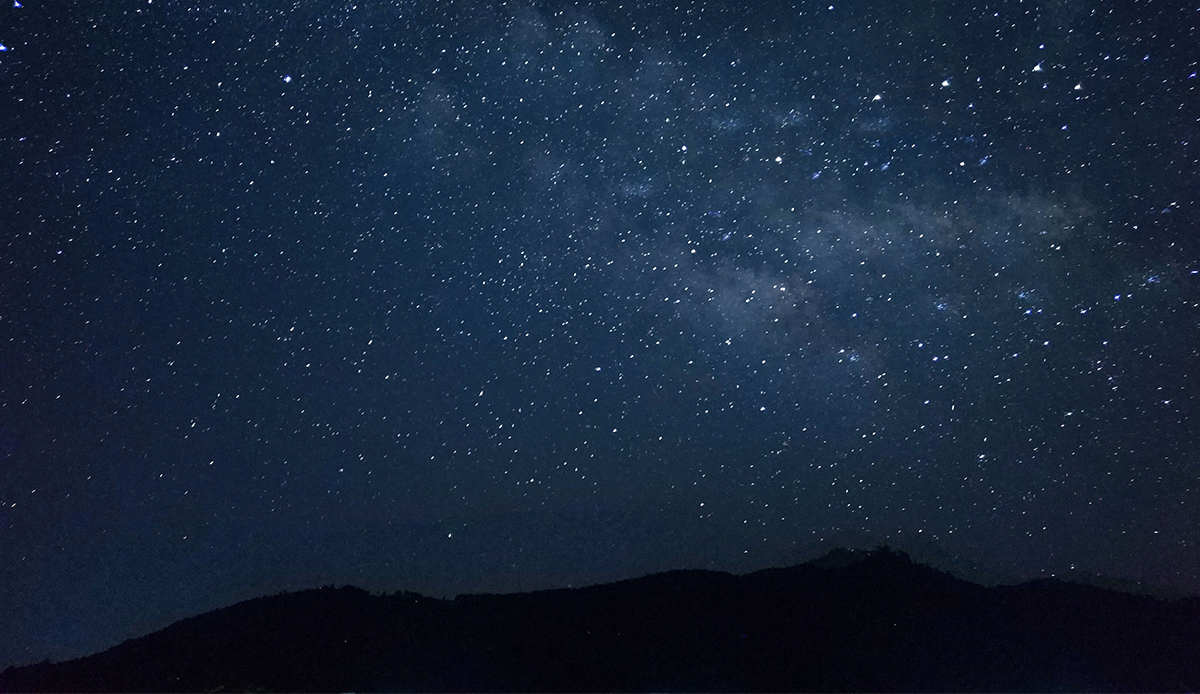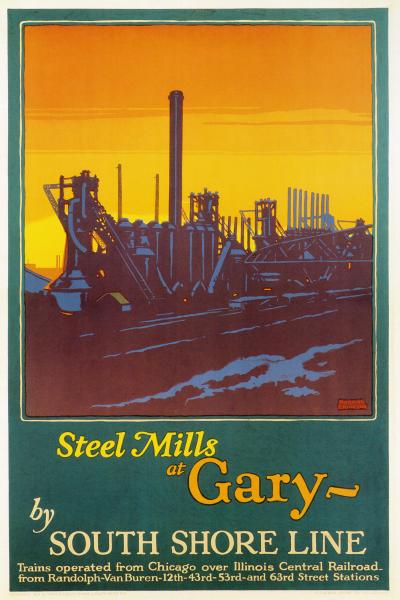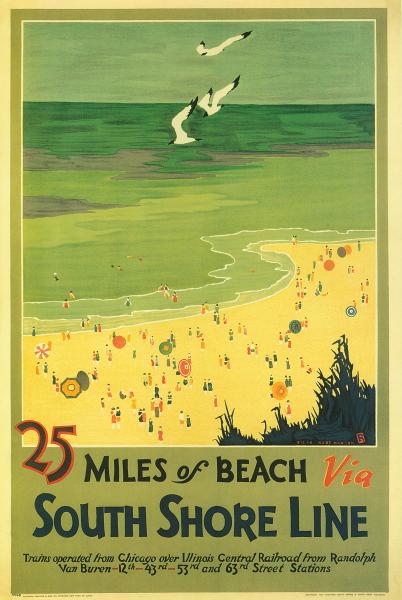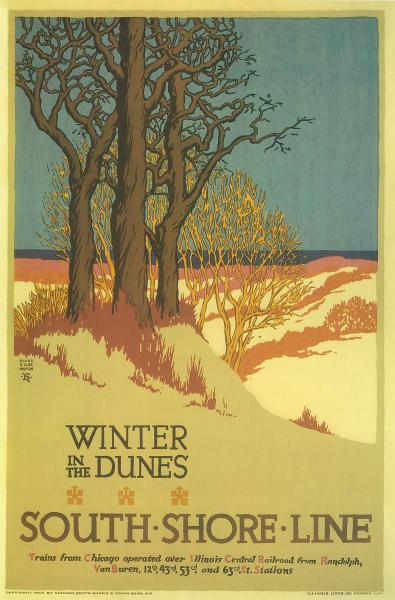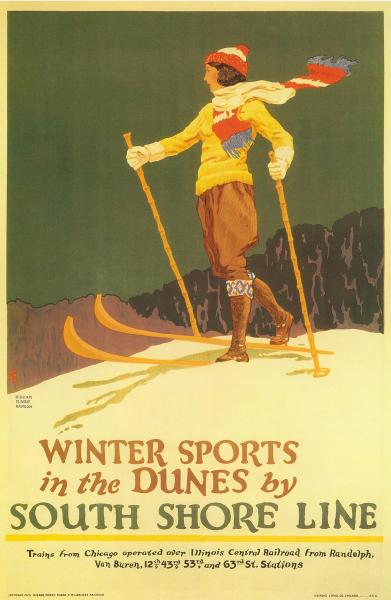The Posters of the South Shore Line
Would you like to visit the towering pines of the Canadian woods? The famous Berkshire Hills of Massachusetts? The cactus country of New Mexico and Arizona? The valley of a quiet stream in Norway? The tamarack lands of our northern states? The broad, sandy beaches of Florida and Southern California? The wilderness of the forest primeval? The home of the trailing arbutus in old New England? The great African desert of the Sahara? The dune country of far off Algeria? A little bit of everywhere is brought together here at the southernmost end of Lake Michigan.
—Recreation Bureau, Chicago, 1920
The posters are in the sackplakat style of Germany—simple object posters that focus on the intrinsic beauty of the thing being advertised. The thing itself—a shoe, a cup, a pencil—is in fact small if it were in its natural habitat, in a display of all that is, or if the thing were one of millions emerging from the factory, but here in the poster this pencil is your pencil. The pencil you will soon desire above all other pencils. In the churning endlessness of manufacturing, you will see it—this car, this tablecloth, this clock, this lamp, this sweater—and you, as the consumer with your power to choose, you will choose it. You will reach out for it, that thing. You will no doubt love it. It will change your life as long as you focus on it.
Of course the designer of this poster, or his bosses, know that you will tire of the advertised thing quickly and suddenly everything that surrounded it in the moment of choosing, all those things you weren’t looking at while you looked at the pencil, they will emerge and make demands on your attention. So they must do their work quickly, focusing your eye on a dying thing.
The posters of the South Shore Line.
AUTUMN IN THE DUNES
In this poster the complex ecology of the Dunes is domesticated. It is always autumn here, and it is the autumn of New England. The bottom two-thirds of the poster depicts woven ribbons of farmland, yellow-orange and green and in the foregound a stylized deciduous tree—the shape of an oak or cottonwood but with the burnt reds and oranges of matches, of flame spreading east and west and north and south. It’s the billowing fire of an iconic autumn tree.
Emerging from the bottom leaves of the tree, the moving flame of color hardens into the straight lines of a farmer’s wagon. The wagon is pulled by two horses. The horse’s bridles are made of tree stuff, that same red orange. The horses are the brown of the tree and the wagon’s shadows. The farmer’s shirt is the yellow green of the plaited farmland.
But his wagon is empty! He is not bringing you food or warmth or harvest. He’s bringing you the idea of those things. The emptiness of the wagon bed is the taupe of the picturesque rooftops folded into the fields behind him. He’s driving on a road that twists in an “S” north, toward the top of the poster, toward the gunmetal blue gray of the sky and the slate color of Lake Michigan and along its shore the tiniest ricrac of dune, that emptiness turned fertile in the imagination.
But perhaps you’ll buy the illusion: the gourds that underscore the lettering. Perhaps you won’t notice the truth in the upper third of the poster: the sky that’s dark with smoke, the fire of the tree like the flame of the steel mills that have been excised from this image. Like the orange and yellow border of the poster, even now if you visit the Dunes you will have to keep your eye purposely focused on the thing you want to see—lake, shoreline, tree or sky—in order to miss the mills. They’re larger than any dune, louder and more spectacular than the lake, as awe-inspiring as any cathedral.
But this is advertising. It means to get you there, or rather, it means to get you there by this particular train where you will buy a ticket and purchase food. What you do once you’re there is not at issue here.
Autumn in the Dunes. South Shore Line.
STEEL MILLS AT GARY
This is more like it. This one is not a lie, or is it? In this poster the colors are reversed. The yellows and oranges of the maple leaves are now coloring the sky, but softer. Less fire and more buttery. The lemon yellow of sun spreads out along the horizon behind the mills, like a halo, like freshly minted coins.
The mills themselves are static. There’s no sense of movement. The sky is more awe-inspiring to the artist, though in real life both the sky and the lake are almost erased by the massive structures and by the noise and smoke. From the poster, the mills look as unthreatening as a passenger train, as a teenage rock star. The mills are blackened purple shapes with no less than twenty projectiles, missiles, pointed toward heaven, their vertical shapes dark in the orange sky as though all the swamps and bogs and shadows and deep caves and holes in the world came together and erupted into the shape of factories.
Running up the shaft of largest smokestack, down the center, there’s a vein of neon blue. Yes, it’s phallic. The watery blue is the color the lake might be if you could see it. The lake has been incorporated in the mill; it draws its boundaries, it makes them visible. There’s a pool of the neon blue spilled out in the foreground in the shape of a body. It’s a woman’s body. There’s the pelvic bone and there’s the left arm reaching over the head. Is she dead? Is she in ecstasy? She’s lying on the ground. If in some sort of gestalt you refocus on the blue-black ground, you see the bust of a man, his head nestled between her watery legs.
It’s there. Look at it.
The Steel Mills at Gary. South Shore Line.
25 MILES OF BEACH
How lovely! A swirl of gray-green shore and a lake that’s teal and lavender and gray and the sandy color of the sand and three bright white gulls offering up the watercolor paper underneath the illusion of sand and water. And the black tips of the gulls wings and the black beaks and the black tails and all the sandy white faces of the dots of humans standing in their groups of two and three with their red and blue and yellow circles of umbrella and their red and blue and yellow woolen garments and in the foreground, to the right a splotch of black vegetation for balance, possibly weeds, their tips echoing the origami shape of the flying white birds. And from Gary to the west and Michigan City thin white strips of something in the lake and between them the shape of a man’s face, the same face as the one in the pool of lake at the foot of the steel mills.
Twenty five Miles of Beach! Via the South Shore Line.
WINTER IN THE DUNES
The khaki of the sand offers up a good background for three stylized snowflakes and for the lettering and at the top of the sand there are three bare trees. Who is crucified here? The trees are bare, I tell you, and they keep going long after they’re cut off by the top of the poster. And the shadows of the trees are rust colored and the thistle at their base is rust colored and the sky the gray blue of eyes. You could not walk into this scene. You wouldn’t know where to step. You would be walking uphill toward Calvary.
Lake Michigan in the winter looks like the Arctic. A frozen planet. Windblown miniature glaciers of ice and snow. The wind will stop your breath.
Winter in the Dunes. The South Shore Line.
WINTER SPORTS IN THE DUNES
The theme of rust continues, though in fact the colors of winter in Duneland are blue-white and blue-gray and gray without the blue. The woman’s rust colored pants in her rust colored boots above the rusted letters. Her sweater is yellow and her white scarf flies behind her like gulls though she’s not particularly in motion and there is no sign of wind. Again the shadows of trees gather behind her, black and purple like a bruise or like the mills behind Ogden Dunes. There are plum-colored areas in the black and they look like the stylized drawings of dancing figures on a Greek vase. They are men working in the mills, covered with sweat and grime, but the woman will soon be skiing in her rust colored clothing with her clean white gloves and the poles fresh cut from tree branches. The Dunes, what’s left of them, can serve as a toboggan or a ski slope. Come to Indiana and try them! Don’t look to your left as you pass by Gary. Just sled or ski or roll toward the lake. But be careful, because the lake is crusted with dangerous ice up toward the shore. It looks like sand or shoreline. You will get trapped in pockets of water underneath it.
But that fact, like the mills and the invisible workers, is beyond the scope of this poster.
Winter Sports in the Dunes. By South Shore Line.
Recommended
Nor’easter
Post-Op Appointment With My Father
Cedar Valley Youth Poet Laureate | Fall 2024 Workshop


